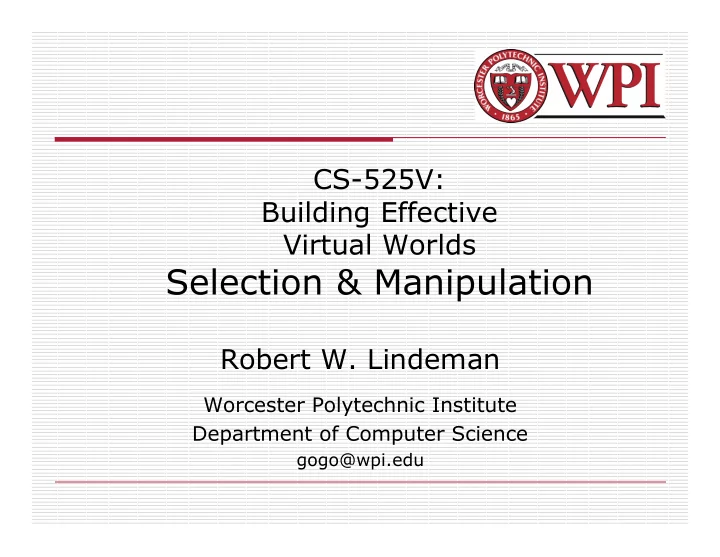

CS-525V: Building Effective Virtual Worlds Selection & Manipulation Robert W. Lindeman Worcester Polytechnic Institute Department of Computer Science gogo@wpi.edu
Overview How do we choose objects? Selecting single objects Disambiguation Selecting groups of objects Releasing objects How do we change objects? Choosing among object properties Natural mappings of actions to changes Arbitrary mappings R.W. Lindeman - WPI Dept. of Computer Science 2
Object Selection In the real world, we select by Touching/grabbing Pointing With finger: direct With pointer: extended With mouse: indirect Voice Device Car radio Other ways Context? Eye gaze? R.W. Lindeman - WPI Dept. of Computer Science 3
Selection-Task Decomposition Indicate Denote which object we intend to select Can be open-loop or closed-loop task Confirm Verbal Dwell Click R.W. Lindeman - WPI Dept. of Computer Science 4
Selection in VR Indication Avatar-hand movement Device movement Virtual "beam" for closed-loop feedback Selection from a list Confirmation Click Dwell Verbal R.W. Lindeman - WPI Dept. of Computer Science 5
Reaching Objects Need to be able to indicate at a distance Go-go techniques Two-handed pointing Worlds-in-Miniature (WIM) techniques Flashlight Voodoo dolls Image-plane techniques R.W. Lindeman - WPI Dept. of Computer Science 6
Manipulation Typical tasks (Re)Position Rotate Property modification Approaches WIM 3D widgets Virtual sphere for rotations Jack for scaling Non-isomorphic position/rotation Skewers 2D widgets R.W. Lindeman - WPI Dept. of Computer Science 7
Design Guidelines Use existing techniques unless a large amount of benefit might be derived from designing a new, application-specific technique Use task analysis when choosing a 3D manipulation technique Match the interaction technique with the device Use techniques that can help reduce clutching Non-isomorphic techniques are more useful and intuitive R.W. Lindeman - WPI Dept. of Computer Science 8
Design Guidelines (cont.) Use pointing techniques for selection, and virtual hand techniques for manipulation Use grasp-sensitive object selection Constrain degrees of freedom when possible There is no, single best interaction technique Test, test, test! [Bowman, Kruijff, LaViola, Poupyrev, 3D User Interfaces , 2005] R.W. Lindeman - WPI Dept. of Computer Science 9
Recommend
More recommend